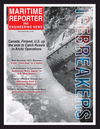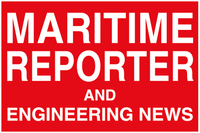
Page 14: of Maritime Reporter Magazine (November 2025)
Read this page in Pdf, Flash or Html5 edition of November 2025 Maritime Reporter Magazine
Digitalization loaded reel deck. The system pushed route and speed set-points
The Road Ahead: Five Bets for the Near Future to stay within lashing design limits, along with a dynamic in- • From visibility to foresight: Congestion prediction will spection checklist, to the chief mate and superintendent. The move from research to routine operations, with carriers and shipment cleared with no rework at the destination and avoid- ports aligning incentives around earlier re-sequencing and ed a likely claims dispute. (Lesson: the winning move was berth swaps. featuring engineering, turning weather grids into acceleration • Cyber telemetry as an ETA variable: As ports publish exceedance probabilities, not a prettier weather overlay.) security posture signals, voyage/ETA forecasts will incorpo- • Case C – Gulf re? nery export chain (liquids): rate cyber risk the way they integrate already weather.
A re? ner’s marine desk linked berth sensors, custody trans- • Embedded sustainability: AI-assisted conning and route fer logs, and trucking/rail ETAs to forecast line pack and ? are optimization will be measured in avoided tonnes of CO and 2 risk during a maintenance cycle. The model recommended MARPOL-aligned compliance, not just minutes saved. Ex- swapping two inbound parcels and pre-positioning a chartered pect charter parties to reference these metrics directly. barge. Net: no demurrage, reduced ? aring, and tighter product • Standardized data products: S-100’s approach will in? u- specs. (Lesson: treating terminal + hinterland as one system ence broader logistics data products (e.g., standardized berth surfaced options that neither side saw alone.) availability tiles, channel condition layers, and terminal per- formance feeds) that any ecosystem player can subscribe to.
Architecture: The Maritime Data Flywheel • Autonomous and semi-autonomous sensing: Persistent
A resilient pattern is emerging across ? eets and ports: Ocean drones and pier-side sensors will ? ll blind spots, feed- • Open ingestion layer: stream AIS, ECDIS/NOON, en- ing predictive maintenance and security models across blue gine telemetry, weather, tides, satellite imagery, port commu- and brown water corridors. nity feeds, and cybersecurity logs.
• Standards & semantics: anchor on mature schemas (e.g.,
Challenges & Considerations the S-100 family, where relevant for nav layers) and build a Implementing a big data pipeline in the maritime industry shared business ontology for port/terminal logistics events. requires addressing several key challenges: • Feature store: reusable features such as “ETA slippage • Data integration: Maritime data is often siloed and velocity,” “berth contention index,” “probable speed loss,” comes from varied, usually unstructured, sources, requiring “approach instability,” and “gate dwell predictor.” signi? cant effort to standardize and integrate.
• Model factory: time-series forecasting for ETA and • Data quality: Ensuring the accuracy of data from a multi- dwell, classi? cation for encounter risk, reinforcement learn- tude of sources is critical for reliable analysis.
ing for routing under constraints, anomaly detection for OT/ • Talent shortage: The industry often lacks employees with
IT security. the specialized skills needed to manage and analyze big data • Decision integration: APIs into VTS/port community effectively.
systems, the carrier’s NOC, terminal operating systems, • Cybersecurity risks: The increased reliance on digital
WMS/TMS, and crew decision-support, so predictions turn systems exposes operations to greater cybersecurity threats, into bookings, plans, and alerts. necessitating robust security measures.
• Learning loop: post-voyage audits reconcile plan vs. ac- • High costs: Implementing advanced AI and big data sys- tual, retraining the models, and hardening governance. tems requires signi? cant investment in infrastructure, soft-
Big data without governance becomes the next silo. Three ware, and training. rules keep programs credible: Few were rightly skeptical in 2015, asking whether big data 1. Provenance & quality: A shared catalogue that records held more value or risk, and in the same year, documenting data lineage, sensor calibration, and last-known reliability. how data-driven ops were already delivering signi? cant sav- 2. Privacy & security by design: Zero-trust access, encryp- ings in practice. Today, the question is settled: the winners tion, and strict purpose limitation, especially for OT streams. are the teams that engineer data end-to-end, align predictions
The LA CRC model of shared intel with strong controls is with decisions, and keep humans in the loop. The industry instructive. doesn’t need more heat maps. It requires reliable foresight 3. Human-in-the-loop ops: Stakeholders must be able to that prevents demurrage, avoids damage, protects crews, and see why the system recommends a decision and how it affects maintains schedules in a volatile world. That is the promise, safety margins, not just costs. and the payoff, of big data done right. 14 Maritime Reporter & Engineering News • November 2025
MR #11 (1-17).indd 14 MR #11 (1-17).indd 14 11/3/2025 1:28:18 PM11/3/2025 1:28:18 PM

 13
13

 15
15
